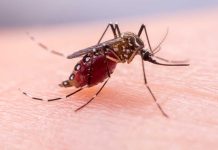
Cat Scratch Fever Fact Sheet — Yes, It’s Totally Real
(DailyDig.com) – It’s common belief that cat-related diseases are old wives’ tales, and not to be taken seriously. Unfortunately, in the instance of Cat Scratch Fever, the myth is the truth. If a person is near playful kittens or a flea infestation, it’s even more likely that Cat Scratch Fever can occur.
What Is Cat Scratch Disease?
Cat Scratch Disease, also known as CSD, is a bacterial infection. This infection occurs when an infected cat scratches or bites someone hard enough to break their skin — or if an infected cat licks a human’s open wound. The Centers for Disease Control and Prevention (CDC) categorizes this as a pathogenic bacteria. Since about 40 percent of all cats have Bartonella henselae, the bacteria that causes CSD, you have a 40 percent chance of potential infection if scratched or bitten. This is why it’s critical to tend to the wound immediately.
Kittens are more likely to carry the bacteria and cats carrying it are usually asymptomatic. The bacteria comes from fleas via bites and dirt. When cats become
What Are CSD Symptoms?
Cat Scratch Disease is characterized by a fever, exhaustion or fatigue, headache, and a poor appetite. Swollen lymph nodes may occur, especially near the area that was scratched. They will feel painful, tender, and swollen. A large pustule may develop near the scratch site. CSD is more common in fall and winter, and with children under 15 years of age or those with weak immune systems.
Additionally, it’s possible that a cat is symptomatic. If so, they will have a fever for two to three days. If they have the additional above described symptoms, they must be seen by a veterinarian immediately. Dogs and other animals can get CSD, and it’s carried in the saliva of the infected cat.
What Should a Person Do After Being Scratched By a Cat?
If a person gets a cat scratch or bite, they should immediately wash the affected site with running water and soap. They should spend over thirty seconds cleaning the site with soap and water. If available, the person may also treat the wound area with alcohol and bandages. Following the immediate cleaning, the person should see a doctor immediately. Urgent care is often the best choice for treatment when it comes to minor injuries at risk of infection such as this. A doctor may perform blood tests, and they may also prescribe antibiotics and other general symptom treatment.
What Can Happen If a Cat Scratch Victim Ignores the Cat Scratch?
If someone does not treat a cat scratch or bite properly or ignores the symptoms of cat scratch fever, they could develop one of two serious problems.
- Bacillary angiomatosis: Seen on the skin, bacillary angiomatiosis presents as lesions with an outer ring that is scaly in texture. If it becomes more widespread, it can harm a person’s internal organs.
- Parinaud’s oculograndular syndrome: Imagine pink eye, but worse. The eye becomes swollen, the person experiences a fever, and they also get swollen lymph nodes closer to the eye, in front of the ear.
Additionally, anyone with weakened immune systems is more likely to experience these complications.
To prevent Cat Scratch Fever and Cat Scratch Disease, people should keep their cats indoors. Declawing is not necessary or recommended. Always treat domestic animals with flea preventatives per their veterinarian. Avoid stray cats, cats with fleas, or cats in poor health. If a person does get scratched, they should monitor the site for up to three weeks, as tender lymph nodes can be a late symptom. If there are any questions, consult a medical doctor immediately.
Copyright 2022, DailyDig.com













